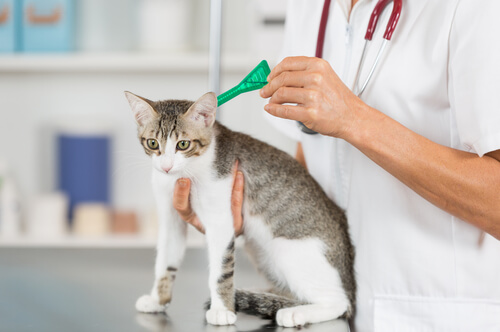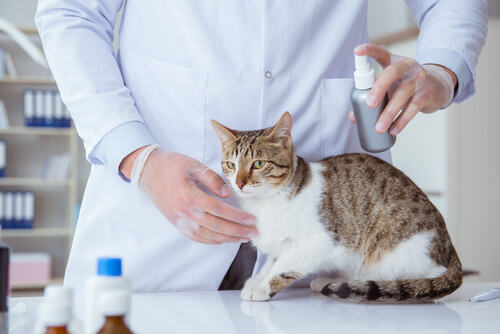Cat Fleas: How to Protect Your Cat Against Parasites

Fleas are parasites that live on the bodies of many animals and birds. Their bite can infect the host with dangerous bacteria, causing diseases such as bartonellosis. It’s also fairly common for cats and dogs to be allergic to flea bites. So, to stop your pet getting bitten by cat fleas, you need to protect it against external parasites.
In this article, we want to tell you about different ways you can protect your pet against cat fleas.
Bartonellosis: a flea-transmitted disease
Bartonellosis is caused by Bartonella bacteria. It commonly lives in the digestive tract of fleas, and is excreted in their waste. When a cat or other animal is bitten by fleas carrying this bacteria, it is at great risk of infection.
Cats can also become infected during fights with other cats, as any wounds they sustain can come into contact with infected blood. Similarly, people can contract bartonellosis if they are scratched by an infected cat.
If you want to prevent bartonellosis, it’s important to protect your cat by treating it with antiparasitics. If possible, you should also take steps to stop your pet from going out and fighting with other cats. Neutering is a good way to do this.
Flea collars for cats
Flea collars are a good option if you want to protect your cat long-term. There are a variety of flea collars on the market, which guarantee several months of protection. These collars release small doses of antiparasitic over an extended period of time. How long they protect your cat will vary from product to product.

If you buy a good quality collar – which we’d highly recommend doing – it will also offer your cat long term protection against other parasites such as ticks and mosquitoes.
Cat fleas: antiparasitic pipettes for cats
If you don’t want to use a flea collar for fear that your cat might chew it, or because your cat refuses to wear a collar, there are other ways to protect them. One option is to buy antiparasitic pipettes, that allow you to apply the product directly to your pet’s skin.

Apply the antiparasitic to the skin on the neck and shoulders. The skin absorbs the liquid within a few hours, but until then, you need to make sure that neither it nor another cat licks the fur around the application site.
One advantage antiparasitic pipettes have over flea collars is how easy they are to apply. Once the skin has absorbed all the product, there’s really nothing else for you to do. The antiparasitic will usually protect against other parasites too, but this will depend on the brand and the quality of the product.
One disadvantage is they won’t protect your pet for quite as long as flea collars. Your antiparasitic will protect your cat for a few weeks, and then you’ll have to apply a new dose of treatment.
Both pipette and collar flea treatments are classified according to dose size. The dose your cat needs will depend on its weight. Another factor you’ll need to take into account is the age of your pet. Normally, the age you can start using flea treatments will be stated on the packet.
Cat fleas: antiparasitic sprays for cats
Antiparasitics also come in spray form, and are great at protecting your cat from fleas and other parasites. They are really easy to use; all you need to do is spray the product onto your pet.

These sprays generally kill fleas, ticks and lice in around 24-48 hours. They’re really useful if you want to get rid of a current flea infestation, or reinforce the protection offered by a flea collar or pipette flea treatment.
However, sprays are only a short-term solution: within a few days of spraying your pet, the treatment will wear off, and your cat will be unprotected once again. As a result, they should be used alongside other antiparasitics.
These are the main antiparasitic treatments you’ll find on the market. We would always recommend buying them from a specialist store or vet clinic. If you have any doubts, be sure to consult your vet.
Never use an antiparasitic designed for dogs on your cat
This is extremely important. The majority of antiparasitics for dogs contain a chemical called Permethrin, which is extremely toxic to cats. It goes without saying that feline antiparasitics are permethrin free.
If you own both cats and dogs, you need to be extremely careful about using flea treatments containing permethrin on your dog. If you’ve used a pipette, make sure your cat doesn’t lick the area around the application site.
Similarly, if you’ve used a collar, make sure they don’t bite or chew it. If you’re worried your cat might have ingested any of the antiparasitic you’ve used on your dog, seek veterinary attention immediately.
Fleas are parasites that live on the bodies of many animals and birds. Their bite can infect the host with dangerous bacteria, causing diseases such as bartonellosis. It’s also fairly common for cats and dogs to be allergic to flea bites. So, to stop your pet getting bitten by cat fleas, you need to protect it against external parasites.
In this article, we want to tell you about different ways you can protect your pet against cat fleas.
Bartonellosis: a flea-transmitted disease
Bartonellosis is caused by Bartonella bacteria. It commonly lives in the digestive tract of fleas, and is excreted in their waste. When a cat or other animal is bitten by fleas carrying this bacteria, it is at great risk of infection.
Cats can also become infected during fights with other cats, as any wounds they sustain can come into contact with infected blood. Similarly, people can contract bartonellosis if they are scratched by an infected cat.
If you want to prevent bartonellosis, it’s important to protect your cat by treating it with antiparasitics. If possible, you should also take steps to stop your pet from going out and fighting with other cats. Neutering is a good way to do this.
Flea collars for cats
Flea collars are a good option if you want to protect your cat long-term. There are a variety of flea collars on the market, which guarantee several months of protection. These collars release small doses of antiparasitic over an extended period of time. How long they protect your cat will vary from product to product.

If you buy a good quality collar – which we’d highly recommend doing – it will also offer your cat long term protection against other parasites such as ticks and mosquitoes.
Cat fleas: antiparasitic pipettes for cats
If you don’t want to use a flea collar for fear that your cat might chew it, or because your cat refuses to wear a collar, there are other ways to protect them. One option is to buy antiparasitic pipettes, that allow you to apply the product directly to your pet’s skin.

Apply the antiparasitic to the skin on the neck and shoulders. The skin absorbs the liquid within a few hours, but until then, you need to make sure that neither it nor another cat licks the fur around the application site.
One advantage antiparasitic pipettes have over flea collars is how easy they are to apply. Once the skin has absorbed all the product, there’s really nothing else for you to do. The antiparasitic will usually protect against other parasites too, but this will depend on the brand and the quality of the product.
One disadvantage is they won’t protect your pet for quite as long as flea collars. Your antiparasitic will protect your cat for a few weeks, and then you’ll have to apply a new dose of treatment.
Both pipette and collar flea treatments are classified according to dose size. The dose your cat needs will depend on its weight. Another factor you’ll need to take into account is the age of your pet. Normally, the age you can start using flea treatments will be stated on the packet.
Cat fleas: antiparasitic sprays for cats
Antiparasitics also come in spray form, and are great at protecting your cat from fleas and other parasites. They are really easy to use; all you need to do is spray the product onto your pet.

These sprays generally kill fleas, ticks and lice in around 24-48 hours. They’re really useful if you want to get rid of a current flea infestation, or reinforce the protection offered by a flea collar or pipette flea treatment.
However, sprays are only a short-term solution: within a few days of spraying your pet, the treatment will wear off, and your cat will be unprotected once again. As a result, they should be used alongside other antiparasitics.
These are the main antiparasitic treatments you’ll find on the market. We would always recommend buying them from a specialist store or vet clinic. If you have any doubts, be sure to consult your vet.
Never use an antiparasitic designed for dogs on your cat
This is extremely important. The majority of antiparasitics for dogs contain a chemical called Permethrin, which is extremely toxic to cats. It goes without saying that feline antiparasitics are permethrin free.
If you own both cats and dogs, you need to be extremely careful about using flea treatments containing permethrin on your dog. If you’ve used a pipette, make sure your cat doesn’t lick the area around the application site.
Similarly, if you’ve used a collar, make sure they don’t bite or chew it. If you’re worried your cat might have ingested any of the antiparasitic you’ve used on your dog, seek veterinary attention immediately.
This text is provided for informational purposes only and does not replace consultation with a professional. If in doubt, consult your specialist.








